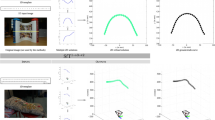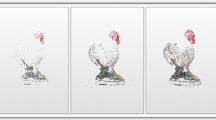Abstract
One of the most challenging goals in digital shape reconstruction is to create a high-quality surface model from measured data with a minimal amount of user assistance. We present techniques to automate this process and create a digital model that meets the requirements in mechanical engineering CAD/CAM/CAE. Such a CAD model is composed of a hierarchy of different types of surfaces, including primary surfaces, connecting features and vertex blends at their junctions, and obey a well-defined topological structure that we would like to reconstruct as faithfully as possible. First, combinatorially robust segmentation techniques, borrowed from Morse theory, are presented. This is followed by an algorithm to create a so-called feature skeleton, which is a curve network on the mesh that represents the region structure of the object. The final surface structure comprises the optimally located boundaries of edge blends and setback vertex blends, which are well aligned with the actual geometry of the object. This makes the surface structure sufficient for an accurate, CAD-like surface approximation including both quadrangular and trimmed surface representations. A few representative industrial objects reconstructed by Geomagic systems illustrate the efficiency and quality of the approach.
Preview
Unable to display preview. Download preview PDF.
Similar content being viewed by others
References
Agarwal, P., Edelsbrunner, H., Harer, J., Wang, Y.: Extreme elevation on a 2-manifold. In: Proc. 20th Ann. Symp. on Computational Geometry, pp. 357–365 (2004)
Benko, P., Varady, T.: Algorithms for reverse engineering boundary representation models. Computer-Aided Design 33(11), 839–851 (2001)
Benko, P., Varady, T.: Segmentation methods for smooth point regions of conventional engineering objects. Computer-Aided Design 36, 511–523 (2004)
Braid, I.: Non-local blending of boundary models. Computer-Aided Design 29(2), 89–100 (1997)
Csakany, P., Wallace, A.M.: Computation of local differential parameters on irregular meshes. In: Cipolla, R., Martin, R.R. (eds.) The Mathematics of Surfaces IX, pp. 19–33. Springer, Heidelberg (2000)
Eck, M., Hoppe, H.: Automatic reconstruction of B-spline surfaces of arbitrary topological type. In: Computer Graphics, SIGGRAPH 1996, pp. 325–334 (1996)
Edelsbrunner, H., Letscher, D., Zomorodian, A.: Topological persistence and simplification. Discrete Computational Geometry 28, 511–533 (2002)
Edelsbrunner, H., Harer, J., Zomorodian, A.: Hierarchical Morse-Smale complexes for piecewise linear 2-manifolds. Discrete Computational Geometry 30, 87–107 (2003)
Fitzgibbon, A.W., Eggert, D.W., Fisher, R.B.: High-level CAD model acquisition from range images. Computer-Aided Design 29(4), 321–330 (1997)
Gelfand, N., Guibas, L.J.: Shape Segmentation Using Local Slippage Analysis. In: Eurographics Symposium on Geometry Processing, pp. 214–223 (2004)
Heckbert, P.S., Garland, M.: Survey of Polygonal Surface Simplification Algorithms. In: Multiresolution Surface Modeling Course, SIGGRAPH 1997 (1997)
Huang, J., Menq, C.H.: Automatic data segmentation for geometric feature extraction from unorganized 3D coordinate points. IEEE Trans. Rob. Aut. 17(3), 268–279 (2001)
Leonardis, A., Jaklic, A., Solina, F.: Superquadrics for segmenting and modeling range data. IEEE PAMI 19(11), 1295–1298 (1997)
Lee, A., Sweldens, W., Schroeder, P., Cowsar, L., Dobkin, D.: MAPS: multiresolution adaptive parameterization of surfaces. In: Comput. Graphics, Proc., SIGGRAPH 1998, pp. 95–104 (1998)
Mangan, A.P., Whitaker, R.T.: Partitioning 3D surface meshes using watershed segmentation. IEEE Trans. on Visualization and Computer Graphics (1999)
Marks, P.: Capturing a Competitive Edge through Digital Shape Sampling & Processing (DSSP), SME, Blue Book Series (2005)
Milnor, J.: Morse Theory. Princeton Univ. Press, New Jersey (1963)
Razdan, A., Baeb, M.S.: A hybrid approach to feature segmentation of triangle meshes. Computer-Aided Design 35, 783–789 (2003)
Sapidis, N.S., Besl, P.J.: Direct Construction of Polynomial Surfaces from Dense Range Images through Region Growing. ACM Trans. on Graphics 14, 171–200 (1995)
Vanco, M., Brunnett, G.: Direct Segmentation of Algebraic Models for Reverse Engineering. Computing, Springer 72(1-2), 207–220 (2004)
Varady, T., Hoffmann, C.M.: Vertex blending: problems and solutions. In: Daehlen, M., Lyche, T., Schumaker, L.L. (eds.) Mathematical Methods for Curves and Surfaces II, pp. 501–527. Vanderbilt University Press, Nashville (1998)
Varady, T., Martin, R.R.: Reverse Engineering, ch. 26. In: Farin, G., Hoschek, J., Kim, M.–S. (eds.) Handbook of Computer Aided Geometric Design, pp. 651–681. North-Holland, Amsterdam (2002)
Varady, T., Facello, M.A.: New trends in digital shape reconstruction. In: Martin, R.R., Bez, H., Sabin, M. (eds.) The Mathematics of Surfaces XI, pp. 395–412. Springer, Heidelberg (2005)
Vieira, M., Shimada, K.: Surface mesh segmentation and smooth surface extraction through region growing. Computer Aided Geometric Design 22, 771–792 (2005)
Author information
Authors and Affiliations
Editor information
Editors and Affiliations
Rights and permissions
Copyright information
© 2006 Springer-Verlag Berlin Heidelberg
About this paper
Cite this paper
Várady, T., Facello, M.A., Terék, Z. (2006). Automatic Extraction of Surface Structures in Digital Shape Reconstruction. In: Kim, MS., Shimada, K. (eds) Geometric Modeling and Processing - GMP 2006. GMP 2006. Lecture Notes in Computer Science, vol 4077. Springer, Berlin, Heidelberg. https://doi.org/10.1007/11802914_1
Download citation
DOI: https://doi.org/10.1007/11802914_1
Publisher Name: Springer, Berlin, Heidelberg
Print ISBN: 978-3-540-36711-6
Online ISBN: 978-3-540-36865-6
eBook Packages: Computer ScienceComputer Science (R0)




